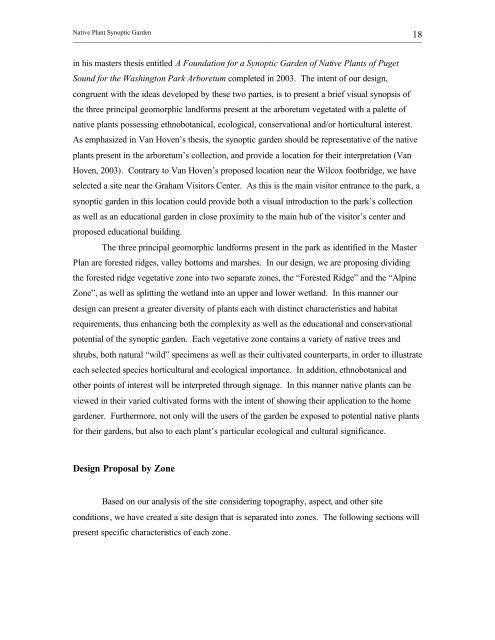Full page photo print - WSU Puyallup Research and Extension ...
Full page photo print - WSU Puyallup Research and Extension ...
Full page photo print - WSU Puyallup Research and Extension ...
You also want an ePaper? Increase the reach of your titles
YUMPU automatically turns print PDFs into web optimized ePapers that Google loves.
Native Plant Synoptic Garden<br />
18<br />
____________________________________________________________________________________________________________<br />
in his masters thesis entitled A Foundation for a Synoptic Garden of Native Plants of Puget<br />
Sound for the Washington Park Arboretum completed in 2003. The intent of our design,<br />
congruent with the ideas developed by these two parties, is to present a brief visual synopsis of<br />
the three principal geomorphic l<strong>and</strong>forms present at the arboretum vegetated with a palette of<br />
native plants possessing ethnobotanical, ecological, conservational <strong>and</strong>/or horticultural interest.<br />
As emphasized in Van Hoven’s thesis, the synoptic garden should be representative of the native<br />
plants present in the arboretum’s collection, <strong>and</strong> provide a location for their interpretation (Van<br />
Hoven, 2003). Contrary to Van Hoven’s proposed location near the Wilcox footbridge, we have<br />
selected a site near the Graham Visitors Center. As this is the main visitor entrance to the park, a<br />
synoptic garden in this location could provide both a visual introduction to the park’s collection<br />
as well as an educational garden in close proximity to the main hub of the visitor’s center <strong>and</strong><br />
proposed educational building.<br />
The three principal geomorphic l<strong>and</strong>forms present in the park as identified in the Master<br />
Plan are forested ridges, valley bottoms <strong>and</strong> marshes. In our design, we are proposing dividing<br />
the forested ridge vegetative zone into two separate zones, the “Forested Ridge” <strong>and</strong> the “Alpine<br />
Zone”, as well as splitting the wetl<strong>and</strong> into an upper <strong>and</strong> lower wetl<strong>and</strong>. In this manner our<br />
design can present a greater diversity of plants each with distinct characteristics <strong>and</strong> habitat<br />
requirements, thus enhancing both the complexity as well as the educational <strong>and</strong> conservational<br />
potential of the synoptic garden. Each vegetative zone contains a variety of native trees <strong>and</strong><br />
shrubs, both natural “wild” specimens as well as their cultivated counterparts, in order to illustrate<br />
each selected species horticultural <strong>and</strong> ecological importance. In addition, ethnobotanical <strong>and</strong><br />
other points of interest will be interpreted through signage. In this manner native plants can be<br />
viewed in their varied cultivated forms with the intent of showing their application to the home<br />
gardener. Furthermore, not only will the users of the garden be exposed to potential native plants<br />
for their gardens, but also to each plant’s particular ecological <strong>and</strong> cultural significance.<br />
Design Proposal by Zone<br />
Based on our analysis of the site considering topography, aspect, <strong>and</strong> other site<br />
conditions, we have created a site design that is separated into zones. The following sections will<br />
present specific characteristics of each zone.

















